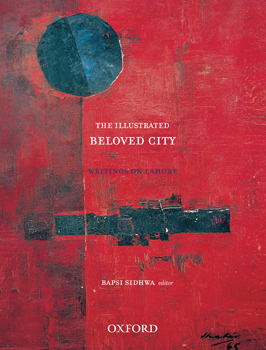“To belong to Lahore is to be steeped in its romance, to inhale with each breath an intensity of feeling that demands expression.” – Bapsi Sidhwa
The Illustrated Beloved City, Writings on Lahore, edited by Bapsi Sidhwa and published by Oxford University Press, is a literary and artistic testament to the enduring magic of one of the world’s oldest living cities.
The much loved and deeply missed Minoo Bhandara shares his memories of the searing experience of the partition of the subcontinent. Before his untimely death, Minoo Bhandara was widely admired and acknowledged for his writing, his unstinting support of Pakistan’s minority groups and as the owner of Pakistan’s iconic Murree Brewery. His essay, Ava Gardner and I: post-partition Lahore recounts his meeting with the Hollywood actress at the Regal Cinema when she and Stewart Granger had come to Lahore to film Bhowani Junction. His memories of Lahore evoke a bygone era and immortalise the fun loving, charming Minoo that so many of us remember.
Another outstanding contribution in this compilation of articles and illustrations is from the legendary lawyer, the late Ijaz Husain Batalvi who writes on Rudyard Kipling’s special association with the city. A searing intellectual and an authority on Lahore’s rich history and culture, I was lucky enough to have been given a guided tour of the city by the charismatic Ijaz Batalvi who explained in detail the history of Lahore’s unique treasures: the Lahore Museum, Kim’s gun, the Sheesh Mahal, the Shalimar Gardens, the Lahore Fort and the Badshahi Mosque.
Batalvi highlights how Lahore remained obdurate against colonial domination until finally defeated in battle, “Lahore was the capital of the Punjab, the last province of South Asia to be annexed by the British in 1849, after the battle of Chelianwala – one of the bloodiest every fought by the English in the subcontinent.”
In her soul-stirring introduction to this anthology, Bapsi Sidhwa laments the posthumous publication of his article, “Ijaz Husain Batalvi was keen to see his essay Kipling’s Lahore published in this collection as I was eager for him to see it. A leading lawyer, scholar, literary critic and writer, he had the ability to engage with all groups. His enthusiasm and intellectual curiosity were infectious.”
The illustrations include Iqbal Hussain’s rendering of the women of Hira Mandi. His paintings of the women of Lahore’ s infamous red lights district are at once captivating, disturbing, electrifying and have catapulted Hussain to international fame. Born and brought up in Lahore’s fabled Hira Mandi or Diamond Market, Hussain’s paintings lay bare the truth about Pakistan’s courtesan culture. All notions of romance, glamour, sensuality are shattered as his paintings capture the ‘dancing girls of Lahore’ in their unguarded, behind-the-scenes moments. Often they are staring blankly into space, their gazes abstracted, looking into a mirror, sitting huddled in a sparsely furnished room, talking on the phone, plainly dressed in faded shalwar kameezes. Beautiful though they are with full figures and cascading dark hair, with great mastery, Hussain exposes the desolation of their lives and the heartlessness of the poverty they endure with a stoic dignity.
The great poets of Pakistan are present in this anthology including the revered saint Bulleh Shah, famed dissident poet Faiz Ahmed Faiz and Habib Jalib. Among the contemporary writers Mohsin Hamid, Jugnu Mohsin, Irfan Husain and Bina Shah share their perspectives on Lahore.
For Bapsi Sidhwa, the image of the grand Badshahi Mosque burnished by the sunset embodies the essence of Lahore, “But it is the Badshahi Mosque, its massively billowing marble domes ignited by the setting sun as one approaches the city from the Ravi bridge, that conjures up the image of Lahore for me. Reputed to be the world’s largest mosque, it is laid out like a jewel before the main gate of the Lahore Fort. Both structures originally stood on the banks of the Ravi, but the depleted river has meandered into a new course a couple of miles to the north. The Badshahi Mosque, its elegant proportions and the way it is situated in relation to the city, is sheer architectural poetry.”






